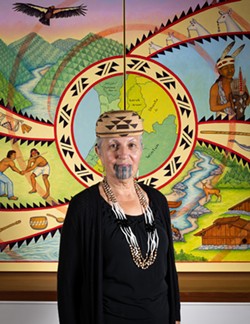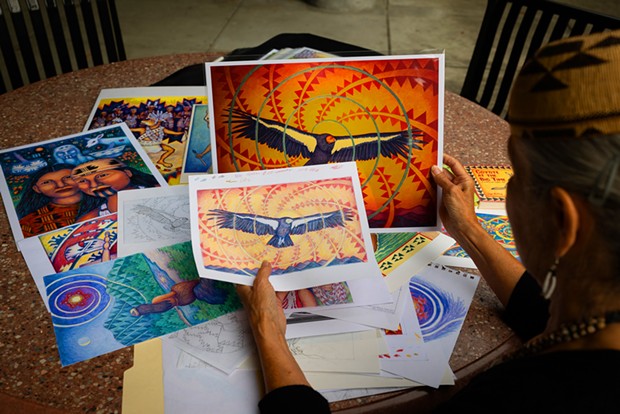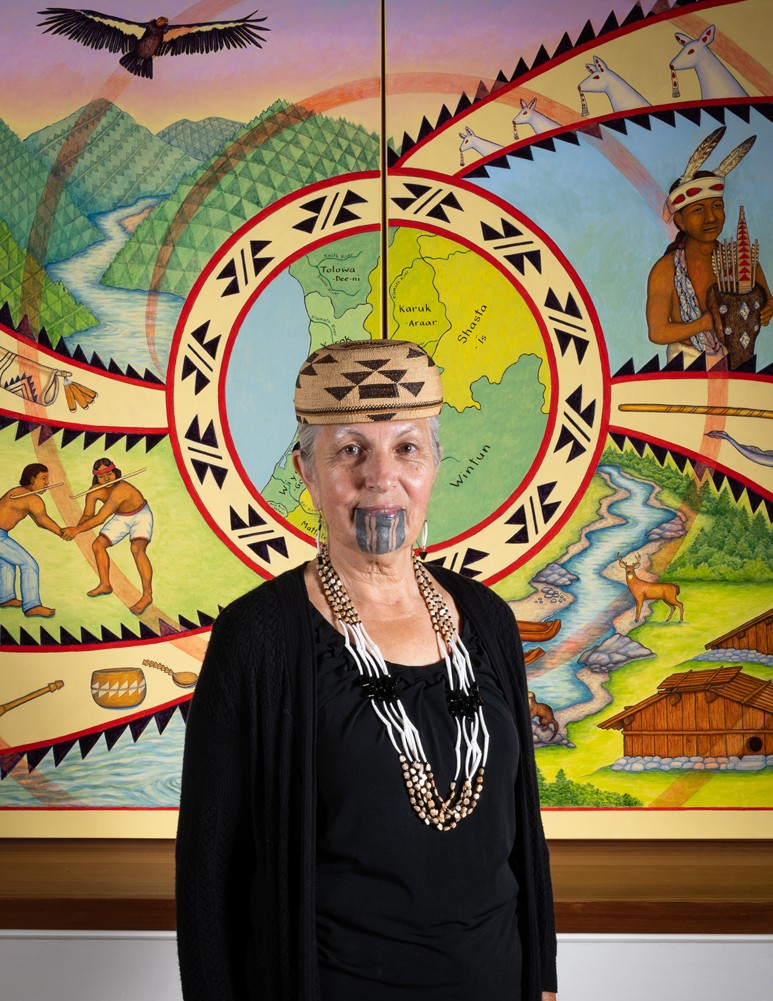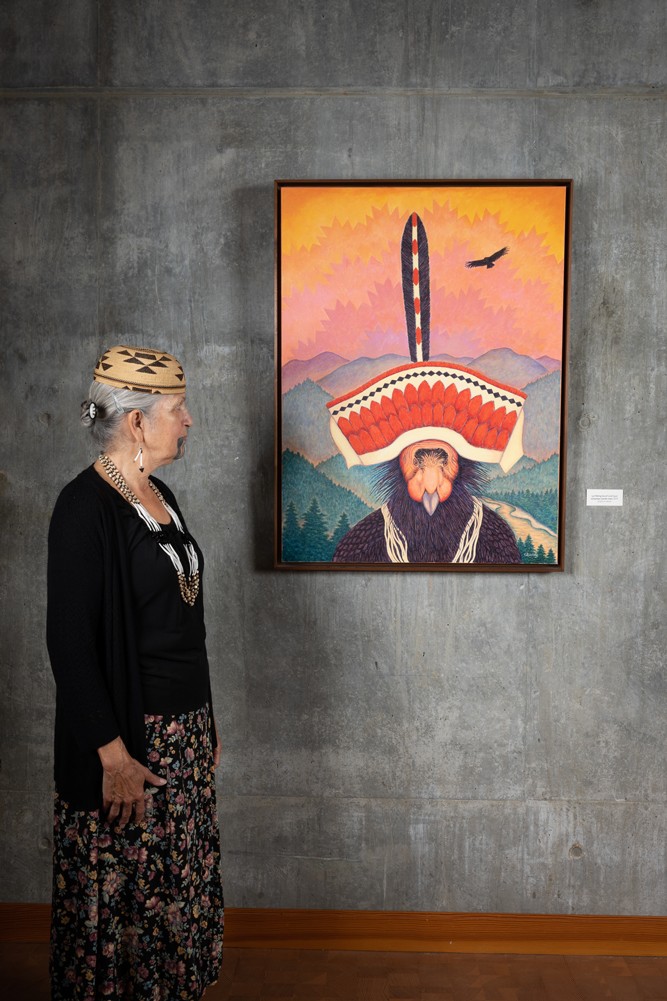Soft spoken and silver haired Lyn Risling is many things: teacher, activist, historian, linguist, mother, grandmother and dancer, to name a few. To the larger Humboldt County community, she is most recognizably an artist.
Risling's career spans several decades, but her relationship with art and with her Native communities stems from a legacy of creators and activists, and her roots spread across the Karuk, Yurok and Hupa lands now called Humboldt County. Her father, a founder of the Native American Studies program at University of California at Davis, was a champion of Indigenous sovereignty and cultural restoration. He was determined to improve education on local reservations, especially in Hoopa, where Risling spent her childhood summers with relatives. "I have been an artist since I can remember. My mother has been an artist and her mother was an artist. On my dad's side, people were basket weavers and regalia makers, especially my grandfather [who inherited] a lot of ceremonial regalia," she says. "I grew up around all of these cultural things." It's not surprising, then, that Risling's art would center on the experiences and traditions of her family and her people.
Both formal training and cultural mentorship came from her time spent earning an art degree at UC Davis, where she was encouraged by Native mentors to "look to [her] own culture" for inspiration and meaning, "and that was a turning point for me," Risling explains. "When I came up to Humboldt County after graduating, I was so hungry, as many people in my generation were, to learn culture and seek out our elder relatives and learn as much as I could." I started to see other California artists that were emerging after I moved up here." Artists like Frank La Pena and Brian Tripp were important influences.
Another defining moment centered around the restoration of the Karuk ihuk coming-of-age ceremony, which Risling chose as the basis for her social science master's thesis at what is now Cal Poly Humboldt. The process took more than five years to complete, and involved creating regalia — including crafting necklaces and bark skirts — using the same materials available to her ancestors centuries ago. She and her daughter (whom the ceremony and Risling's efforts were ultimately for) visited museums and interviewed tribal elders to study regalia, most of which had been sold or destroyed in colonial efforts to eliminate Native cultures and traditions.
"After that ceremony, I really wanted to express the experience I'd gone through with my daughter. My art kind of went from there. Ceremony has been a big part of my adult life ... and that has influenced my art tremendously," Risling says. "That's pretty much what my art is a reflection of — culture and revitalization of traditions." Energized by the experience, Risling went on to work as an art teacher, funded by several grants, incorporating stories vital to Indigenous ways of being on the North Coast, such as those about salmon life cycles, the local rivers and how deforestation and dams threatened it all. Collaborative artworks by Risling and her students can be found in the Potawot Health Clinic, Zane Middle School and on the Wiyot Reservation. Risling spent 18 years with EOP at Cal Poly Humboldt and worked as a graphic artist with local Native organizations, including several on the campus, developing marketing and curricular materials used for Native language learning. One of her largest murals, "We Are These People," painted in 2019, graces the lobby of Native American Forum, where she relays its story to students. She's published two bestselling children's books: A is for Acorn and Coyote at the Bigtime through Heyday Press.
Primarily painted in acrylics, Risling's work embodies several important themes that are themselves a part of Native ways of thinking and moving through the world. "[Native tribes in Humboldt County] have our own distinct cultures," Risling notes. The geometric elements in her work originate in this region and are used by many of the local tribes. "I use a lot of variations of patterns from basketwork in my art," Risling says, referring to the triangular banners and zig-zags that appear in her work. Often, the patterns and the names for them come from what their makers see in nature. "Like that design on the window there," Risling says, pointing to the etched glass in the Native American Forum. It's a motif called "frog foot," she explains, and upon second glance, they do indeed look like the angular legs and feet of a frog.
Juxtaposed and sometimes intertwined with the hard lines of these patterns are rivers, mountains, people. "Mesmerizing" is a word that comes to mind when standing in front of Risling's colorful, vibrant pieces. There is certainly a sense of connection, a tying of things past, present and future, and a feeling that you, the viewer, are also implicated in this continuum. The spirals that twirl through Risling's paintings symbolize the continuation and evolution of Native cultures. "We don't live like we did 150 years ago," Risling says, "but we try to bring forth our traditional values and our relationship to the earth, the land around us, and how we express our appreciation to the earth, our ancestors and all the living things .... There is a need for revival and continuation — not just for Native peoples, but for everyone."
With an art and activism career spanning decades, Risling is now more focused on family. However, Risling conveys a sense that she, herself, is just part of the larger picture, happy to pass the torch to emerging local Native artists like Melitta Jackson, Carl Avery and Alme Allen, whose work is being recognized beyond the Humboldt County lines. "It's wonderful to see up-and-coming artists. [I still hope for] more visibility of Native people on [the Cal Poly] campus and in this community ... but it's exciting to have [community members] — people from my grandfather's generation forward — who make change for the better for Native people as well as others." Risling is certainly counted among them.
You can see some of Risling's work at the current Goudi'ni Gallery show called Recalling from the Source, which runs through Nov. 19, and at lynrisling.com.






